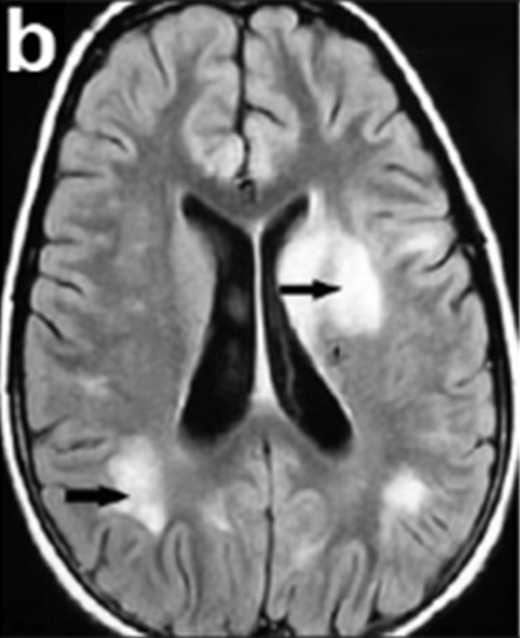Playlist
Show Playlist
Hide Playlist
Acute Disseminated Encephalomyelitis (ADEM)
-
Slides Multiple Sclerosis Inflammatory Disorders of the CNS .pdf
-
Download Lecture Overview
00:02 How about some other acute monophasic illnesses that are auto immune in the central nervous system. 00:08 One, that's very important to recognize is ADEM, or Acute Disseminated Encephalomyelitis. 00:14 And this condition is as the name describes, it's acute in onset. 00:18 Often young children present suddenly after an infection or a vaccination with significant CNS symptoms including brain and often spinal cord. 00:28 It's disseminated. We see inflammation. 00:31 White matter lesions spread throughout the brain and spinal cord all at the same time. 00:36 And it's an encephalomyelitis, when we evaluate patients. 00:39 There's brain pathology, their spinal cord pathology, owing to the location of the lesions. 00:45 This is often a monophasic illness with multifocal demyelination throughout the brain and spinal cord, and it is more commonly seen in children but rarely can be seen in adults. 00:57 New lesions should really not develop beyond a period of about several weeks. 01:02 Patients present suddenly with new symptoms. 01:05 There is florid widespread demyelination within the brain and spinal cord, and patients gradually improve over the course of about four to six, to eight weeks. 01:14 Here we're looking at a typical MRI scan two axial lesions as to axial sequences of an MRI in a patient presenting with ADEM. 01:21 And when we see florid white matter lesions emanating from the ventricles, again, that Dawson's finger like projections extending along the veins, the venous tracks from the ventricles and extending down into the brainstem and subcortical regions as well. 01:39 What are the clinical manifestations with ADEM? Well, neurologic symptoms typically appear between four to 13 days after an infection or vaccination. 01:47 That's the classic presentation that we often see on test questions. 01:50 In clinical practice, there are any inciting event can set off the development of ADEM. 01:56 We see a range of symptoms in these patients owing to both brain and spinal cord lesions, confusion and irritability, sleepiness, lethargy or even coma, acute hemiparesis, cerebellar ataxia, cranial neuropathies - including optic neuritis and myelopathy. 02:13 And there's a range and a very diverse presentations in these patients, which is owed to the location of the lesions. 02:22 How about the diagnosis? How do we diagnose ADEM? Well, MRI of the brain is critically important, we're looking for those poorly marginated bilateral multifocal lesions in both the cortical and subcortical regions. 02:35 Periventricular white matter lesions can be seen but occasionally can be spared in these patients. 02:41 We also would perform MRI of the spine evaluating for brainstem and spinal cord abnormalities and lesions that would support this diagnosis. 02:49 Intramedullary lesions often extend longitudinally over multiple segments on the MRI of the spine. 02:56 And it's not uncommon to see a longitudinally extensive transverse myelitis with a segment of white matter lesion in the spine spanning at least three or more vertebral body segments. 03:09 And then how about treatment? Well, first we want to treat the inciting event the trigger whether that be an infection or time after a vaccination event. 03:19 And then typically immunomodulation is important. 03:22 Corticosteroids is the treatment of choice in those who fail or continue to progress after steroids. 03:27 We may consider intravenous immune globulin or IVIG or plasma exchange.
About the Lecture
The lecture Acute Disseminated Encephalomyelitis (ADEM) by Roy Strowd, MD is from the course Multiple Sclerosis (MS) and Inflammatory Disorders of the CNS.
Included Quiz Questions
Acute disseminated encephalomyelitis (ADEM) is best defined by which statement?
- A monophasic multifocal demyelinating syndrome, more common in children
- A triphasic multifocal demyelinating syndrome, more common in adults
- A monophasic demyelinating syndrome confined to the spinal cord, more common in children
- A monophasic multifocal demyelinating syndrome, more common in adults
Which statement is true regarding ADEM?
- T2-FLAIR MRI is a good imaging modality to use when ADEM is suspected.
- Individuals with ADEM tend to be hypervigilant.
- Neurologic symptoms typically occur three to four months after vaccination.
- ADEM affects only the cerebrum.
Customer reviews
5,0 of 5 stars
| 5 Stars |
|
5 |
| 4 Stars |
|
0 |
| 3 Stars |
|
0 |
| 2 Stars |
|
0 |
| 1 Star |
|
0 |




